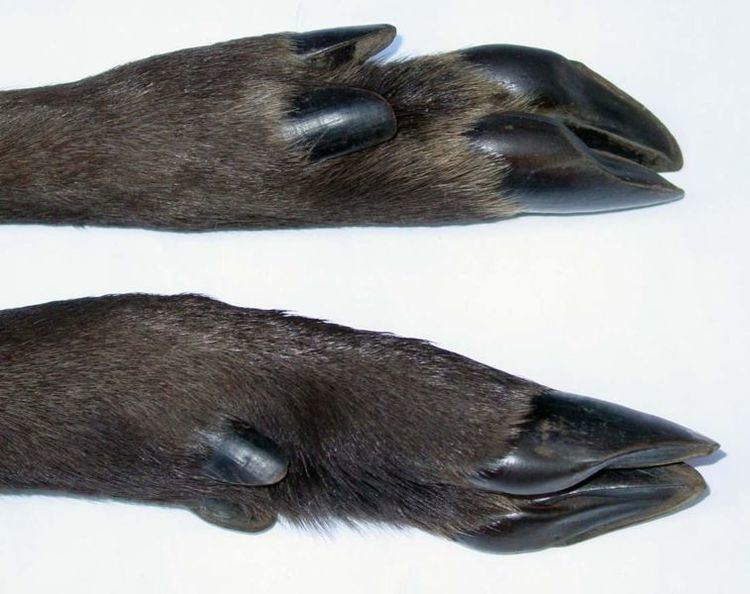 | ||
A hoof (/ˈhuːf/ or /ˈhʊf/), plural hooves (/ˈhuːvz/ or /ˈhʊvz/) or hoofs /ˈhʊfs/, is the tip of a toe of an ungulate mammal, strengthened by a thick, horny, keratin covering.
Contents
Artiodactyls are even-toed ungulates, meaning that these species have an even number of digits on each foot. Ruminants, with two main digits, are the largest group. Examples include deer, bison, cattle, goats and sheep. Perissodactyls have an odd number of toes. Examples of perissodactyl mammals are horses, rhinoceroses and tapirs.
Hooves are generally cited as limb structures restricted to placental mammals, which unlike other mammal groups undergo prolonged pregnancies. However, the marsupial Chaeropus had hooves.
Description
The hoof surrounds the distal end of the second phalanx, the distal phalanx, and the navicular bone. The hoof consists of the hoof wall, the bars of the hoof, the sole and frog and soft tissue shock absorption structures. The weight of the animal is normally borne by both the sole and the edge of the hoof wall. Hooves perform many functions, including supporting the weight of the animal, dissipating the energy impact as the hooves strike the ground or surface, protecting the tissues and bone within the hoof capsule, and providing traction for the animal. Numerous factors can affect hoof structure and health, including genetics, hoof conformation, environmental influences, and athletic performance of the animal. The ideal hoof has a parallel hoof-pastern axis, a thick hoof wall, adequate sole depth, a solid heel base and growth rings of equal size under the coronary band.
There are four layers within the exterior wall of the hoof. From the outside, a hoof is made up of the stratum externum, the stratum medium, the stratum internum and the dermis parietis. The stratum externum and the stratum medium are difficult to distinguish, the stratum externum is thin and the stratum medium is what makes up the bulk of the hoof wall. Inside the hoof wall is a laminar junction, a soft tissue structure that allows the hoof to withstand the demands of force transmission it undergoes. This tissue structure binds the inner surface of the hoof wall, the dermis parietis and the outer surface of the third phalanx.
Most even-toed ungulates (such as sheep, goats, deer, cattle, bison and pigs) have two main hooves on each foot, together called a cloven hoof. Most of these cloven-hooved animals also have two smaller hooves called dewclaws a little further up the leg – these are not normally used for walking, but in some species with larger dewclaws (such as deer and pigs) they may touch the ground when running or jumping, or if the ground is soft. In the mountain goat, the dewclaw serves to provide extra traction when descending rocky slopes as well as additional drag on loose or slippery surfaces made of ice, dirt, or snow. Other cloven-hooved animals (such as giraffes and pronghorns) have no dewclaws.
In some so-called "cloven-hooved" animals, such as camels, the "hoof" is not properly a hoof – it is not a hard or rubbery sole with a hard wall formed by a thick nail – instead it is a soft toe with little more than a nail merely having an appearance of a hoof.
Some odd-toed ungulates (equids) have one hoof on each foot; others have (or had) three distinct hooved or heavily nailed toes, or one hoof and two dewclaws. The tapir is a special case, having three toes on each hind foot and four toes on each front foot.
Management
Hooves grow continuously. In nature, wild animals are capable of wearing down the hoof as it continuously grows, but domesticated species often must undergo specific hoof care for a healthy, functional hoof. Proper care improves biomechanical efficiency and prevents lameness. If not worn down by use, such as in systems like the dairy, ovine and equine industries, hooves may need to be trimmed by a farrier. Appropriate hoof trimming is essential to prevent lameness. Within the equine world, the expression, "no foot, no horse" emphasizes the importance of hoof health. Lameness, behind infertility and mastitis, is the biggest cause of economic loss to a dairy farmer.
Hoof care and trimming is most well known with the equine industry. Problems that can arise with poor horse hoof care include hoof cracks, thrush, abcesses and laminitis.
Uses
Hooves have historical significance in ceremonies and games. They have been used in burial ceremonies.
